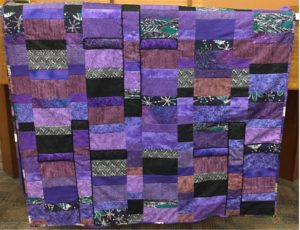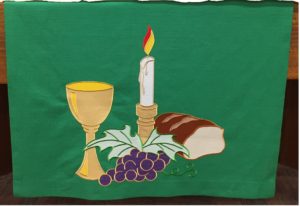Green Ordinary
Green is the color for the season known as “Ordinary Time” or, as we are in right now, the Season after Pentecost, the longest particular season of the church year.
Ordinary Time or Time after Epiphany and Time after Pentecost:
Green is used during these two particular times during the church year and symbolizes growth in Christ. The word ordinary comes from the word ordinal and is used in this sense to mean counted time rather than “common” or “mundane.” (In math an ordinal number is first, second, third, and so on.) To count Sundays during this season, we say, for instance, “The fourth Sunday after Pentecost.”
The green Holy Cross parament features the cup, grapes, and bread of Communion and a lit candle.
Counted time after Pentecost always begins with Trinity Sunday (the first Sunday after Pentecost) and ends with Christ the King Sunday or the Reign of Christ the King (last Sunday before the beginning of Advent).
Luther Rose Banner
This banner created by Nellie Namestka which depicts the Luther Rose is displayed on the niche wall at the front entrance to the fellowship hall. The most enduring symbol of the Lutheran Reformation is the seal that Luther himself designed to represent his theology. By the early 1520s, this seal begins to appear on the title page of Luther’s works.
The black cross symbolizes Jesus’ death and pain and reminds us that it is faith in the Crucified One that saves us.
“For one who believes from the heart will be justified” – Romans 10:10.
The Heart remains its natural color because even though the cross is black, it does not kill our hearts, it doesn’t destroy nature, it does not kill us but keeps us alive,
“The just shall live by faith in the Crucified One”
Romans 1:17.
The white rose shows that faith gives joy, comfort, and peace—it puts the believer into a white, joyous rose.
Faith in Jesus brings true joy, consolation and peace, not worldly joy and peace”
John 14:27
White is the color of the spirits and angels
cf. Matthew 28:3; John 20:12
The sky-blue field symbolizes our hope for the coming joys of heaven. Future joy, which begins now, but is grasped in hope, not yet fully revealed.
Around the field of blue is a golden ring to symbolize that blessedness in heaven lasts forever and has no end. Heavenly blessedness is exquisite, beyond all joy and better than any possessions, just as gold is the most valuable and precious metal.







